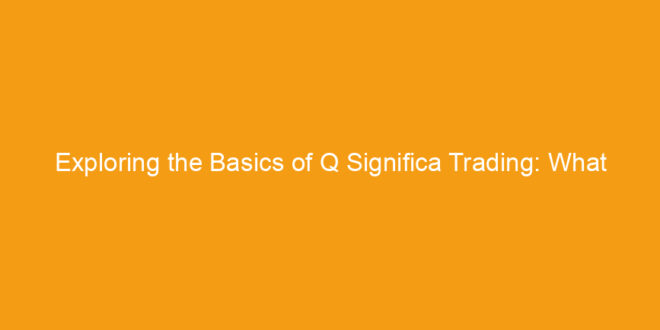Understanding the basics of quantitative trading is essential for anyone looking to get involved in the financial markets. Quantitative trading, or ‘Q trading’ as it is often called, is the practice of using mathematical and statistical models to analyze and trade financial instruments. It is an automated way of trading, which allows traders to execute trades based on the signals generated by their models.
Q trading is a complex field, and there is a lot to learn before attempting to trade. Here are some of the key concepts to understand when getting started with Q trading:
Algorithm: An algorithm is a set of instructions that allow a computer to perform a specific task. In Q trading, an algorithm is a computer program that implements a trading strategy. The algorithm takes in market data and then makes decisions about what trades to place.
Signals: Signals are the data points that the algorithm uses to generate buy and sell signals. These signals can be generated from many sources, including price action, technical indicators, news, and fundamental data. It is important to understand how these signals are generated and used for trading.
Market Data: The data used to generate trading signals comes from the financial markets. This includes price data, volume data, and other information that is used to analyze the market. It is important to understand the different types of data and how they can be used to make trading decisions.
Risk Management: Risk management is a key part of Q trading. It is important to understand the different types of risk and how to manage them. This includes understanding the importance of stop losses, position sizing, and diversification.
Trading Platform: The trading platform is the software used to execute trades. This can be a web-based platform, or a desktop-based platform. It is important to understand the features of the platform and how it can be used to make trading decisions.
These are just a few of the basics of Q trading that you should understand before getting started. It is important to take the time to learn more about these concepts so that you can be successful in the markets. With the right knowledge and understanding, you can become an effective Q trader.
Understanding the Risks of Q Significa Trading
Trading on the Q significa (QS) platform has the potential to yield significant returns, but it also carries certain risks. It is important for investors to understand the risks associated with QS trading before engaging in it.
First, there is the risk of market volatility. Prices on the QS platform can fluctuate rapidly, and if a trader is not prepared for these fluctuations, they could be exposed to losses. To mitigate this risk, traders should always be aware of the current market conditions and adjust their strategies accordingly.
Second, traders should be aware of the risk of liquidity. If a large number of traders enter the market at the same time, it can create a lack of liquidity, which can lead to increased volatility and potential losses.
Third, the risk of counterparty default should also be considered. If a trader is engaging in a contract with another party, they run the risk of the other party not fulfilling their obligation. If this occurs, the trader may be left with a financial loss.
Finally, there is the risk of financial fraud. As with any online platform, there is the potential for hackers, scammers, and other malicious actors to target traders and attempt to steal funds or personal information. It is important for traders to take steps to protect their accounts and information to guard against these risks.
By understanding the risks associated with QS trading, traders can make informed decisions about when and how to engage in the market. It is important to remember that all investments involve risk, but with the proper precautions, traders can maximize their chances of success.
Strategies for Successful Q Significa Trading
1. Develop a Trading Plan: A successful trading plan should include your goals and objectives, risk tolerance, trading strategy, and risk management plan. Take the time to develop a trading plan that works for you, and stick to it.
- Utilize Technical Analysis: Technical analysis is the study of financial market trends and patterns. By studying the historical performance of a particular security, traders can gain insight into where the security might be headed in the future.
- Manage Risk: Risk management is a key component of successful Q Significa trading. Understand the risks associated with trading and make sure you have the appropriate amount of risk capital to place your trades.
- Stay Focused: Trading can be a stressful and time-consuming endeavor. It’s important to stay focused on your goals and objectives and remain disciplined in your trading decisions.
- Monitor the Markets: Staying up to date on market news and events can help you make informed trading decisions. Monitor the markets and stay on top of the news to help you identify potential trading opportunities.
- Take Breaks: Trading can be an emotional roller coaster. Taking regular breaks can help you remain focused and avoid making impulse trades.
- Utilize Stop-Losses: Stop-loss orders can help you manage your risk and limit your losses. Make sure to set reasonable stop-losses that are in line with your risk tolerance.
- Use Leverage Wisely: Leverage allows you to increase your potential profits and losses by using borrowed money. However, leverage can also be risky, so it’s important to use leverage wisely.
- Practice Patience: Trading is a long-term endeavor. Don’t expect to make money overnight, and don’t get discouraged if you experience losses. With patience and discipline, you can achieve success in trading Q Significa.

